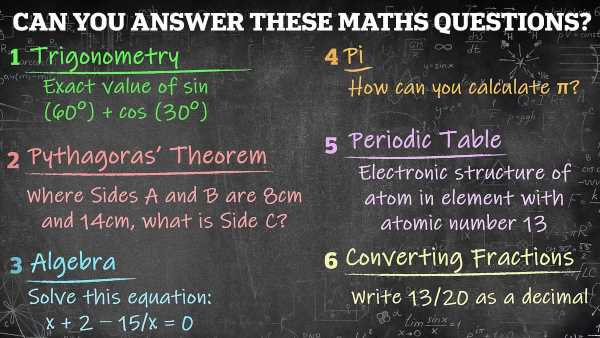Do you know Pythagoras’ theorem? Or how to calculate Pi? Tricky exam questions set for secondary school pupils catch out half of British parents – see how you score on our maths quiz
- Trigonometry and Pythagoras theorem are among topics parents have forgotten
- Algebra, calculating Pi and periodic table also leave mums and dads confused
From trigonometry to Pythagoras’ theorem, there are plenty of mathematical terms you might remember from school – but could you actually answer a question now?
After a survey found half of British parents admit they would fail their secondary school exams if they had to take them again, MailOnline has collated some sample questions for you to test yourself.
Long division, the elements of the periodic table and even the dates of the two world wars are among the things parents are said to have forgotten from their school days.
Some 44 per cent say they have no idea when helping with secondary school homework, while a third (34 per cent) can’t help their primary school-aged children.
Trigonometry (52 per cent), Pythagoras theorem (46 per cent), algebra (46 per cent), calculating Pi (39 per cent) and the periodic table (35 per cent) all leave parents scratching their heads.
Some 15 per cent have forgotten most of the flags of the world and 21 per cent admit they no longer know the difference between a noun, a verb and an adjective.
One in three have no idea how to convert fractions, while a similar number dread long division cropping up.
The difference between types of triangles (26 per cent) and the dates of the two world wars (19 per cent) also leave mums and dads flummoxed.
On average, parents spend four hours a week trying to help their children do their homework, with 73 per cent ending up arguing over it.
Almost nine in ten (87 per cent) say homework has become much more challenging than when they were at school, with 77 per cent believing their children work much harder than they did at the same age.
Maths (57 per cent) is the subject that British parents struggle with the most, according to the study, commissioned by leading online tuition business MyTutor.
Two thirds (66 per cent) get embarrassed when they are not able to do their children’s homework and 16 per cent say they quarrel with their children because the youngsters are cleverer than them.
One in five (19 per cent) of the 2,000 parents surveyed have contacted their child’s school to ask for additional help and a quarter (27 per cent) have considered getting a tutor to help.
MyTutor’s Florence Milner said: ‘Even though most parents devote a significant amount of time weekly to helping their children with schoolwork, it’s unsurprising that many find the task daunting.
‘Few would claim to be expert in every subject, many will have left formal education years before and the vast majority, according to our survey, acknowledge that the curriculum is much more challenging now than when they were in school.’
Now, take MailOnline’s six-question maths quiz to see how well you can do:
QUESTIONS
1) TRIGONOMETRY
Work out the exact value of sin (60° ) + cos (30°) without a calculator.
2) PYTHAGORAS’ THEOREM
In a regular right-angled triangle where the two shorter sides are 8cm (Side A) and 14cm (Side B), what length is the third side (side C)?
3) ALGEBRA
Solve this equation: x + 2 − 15/x = 0
4) PI
How can you calculate Pi?
5) PERIODIC TABLE
For the element has the atomic number 13, what is the electronic structure of an atom? And what is the element?
6) CONVERTING FRACTIONS
Express 13/20 as a decimal.
ANSWERS
1) TRIGONOMETRY
Sin (60° ) = √3/2
Cos (30°) also = √3/2
The calculation is therefore √3/2 + √3/2, which equals √3. So, the answer is √3.
2) PYTHAGORAS’ THEOREM
The third side (Side C) is the triangle’s hypotenuse – the longest side, opposite the right angle. You can use Pythagoras’ Theorem, which is a² + b² = c²
In this triangle, that is 8² + 14² = c², equating to 64 + 196 = c²
c² therefore equals 64 + 196, so 260.
You then need to square root both side to get c.
The square root of 260 – shown as √260 – is 16.1, to one decimal point. So the answer is 16.1cm.
3) ALGEBRA
The first thing to do is get rid of the fraction, which can be done by multiplying the whole equation by x.
This gives you x² + 2x – 15 = 0
Then, factorise the equation by putting it into brackets, giving (x+5)(x-3) = 0.
Solve the equation, meaning x = -5 or x = 3. These two answers are the solution.
4) PI
Pi, expressed as π, can be calculated from all circles when you divide the length of the circumference by the length of the diameter.
The first 10 digits of pi (π) are 3.1415926535.
5) PERIODIC TABLE
The first shell, closest to the nucleus, holds up to 2 electrons.
The second shell must be full, with 8 electrons, before any electrons can occupy the third shell.
Therefore, given that the atomic number is 13, the final 3 electrons occupy the third shell.
The electronic structure is 2,8,3 – which is the answer.
For a bonus point, the element is aluminium.
6) CONVERTING FRACTIONS
You could divide 13 by 20 but there is a simpler method.
Getting to a point where you can divide by 100 is much easier.
You can achieve this by multiplying both parts by 5.
This will result in 13×5 = 65, and 20×5 = 100.
That therefore gives a new fraction of 65/100, which can easily be expressed as a decimal as 0.65 – which is the answer.
Source: Read Full Article


